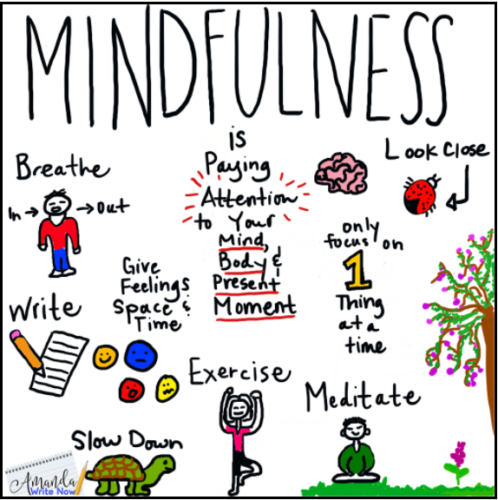
22 Sep Try this ready-to-use mindfulness + meditation mini lesson for grades 3-8
 This article is written by Truth for Teachers writer Amanda Werner.
This article is written by Truth for Teachers writer Amanda Werner.
Many teachers realize that teaching students about mindfulness and meditation is important. But, they aren’t sure how to go about it.
This article includes an easy-to-follow mini-lesson and materials to begin this important journey with your students.
But first, why is it important to teach about mindfulness and meditation?
Why teach about mindfulness and meditation
Mindfulness and meditation practices are needed now more than ever. It’s no surprise that our students are spending an increasing number of hours in front of screens, about 4 hours for tweens and 7 hours for teens according to a study done by Common Sense Media. This large amount of screen time can cause anxiety, depression, poor health, and sleep issues to name just a few concerns.

Mindfulness practices and meditation can alleviate the negative impact that screens have on children and adults. These practices can also help you and your students deal with stress in healthy ways.
How to get started
If you are considering utilizing the introductory mini-lesson below, it’s recommended that you try meditation and mindfulness practices on your own first. This way you learn the challenges and can speak honestly and openly with your students about what’s hard about these practices.
Sometimes when we discover a new idea we can use in our lives and in our classrooms we become convinced that this new idea will be a cure-all. But, we must always remember there will be challenges throughout your mindfulness journey, and that’s normal! The goal is to practice daily, even when it’s hard. The daily practice will eventually have a positive impact, just like any healthy activity we do long-term.
Remember, it’s very important not to force students to meditate. The reason for this is that often students can feel very overwhelmed with meditation practices, especially if they are forced to participate. Before any meditation activity you do with your class, explain to students that their participation is voluntary, but during the meditation activity they need to do something quiet such as doodle or read.
Introductory mini lessons & materials
3rd-5th Grade Mindfulness and Meditation Mini Lesson
6th-8th Grade Mindfulness and Meditation Mini Lesson
Daily Routines
After teaching the introductory mini-lesson to your students, you’ll want to establish routines to keep the momentum going. The awesome news is that there are many routines to choose from! Here are just a few for you to consider:
- Start or end class with 1-3 minutes of silence reminding students to pay attention to their mind, body and breath. Some students may just want to take this opportunity to lay their heads down and rest. Remember, it’s important you don’t force students to close their eyes. This may be very uncomfortable for some students and it’s important to enter this journey with empathy and patience, always keeping in mind the diverse experiences and backgrounds of your students.
- Begin or end the week with a mindfulness game. These games are fun and meant for kids of all ages. *This is an Amazon Affiliate link, which means that if you purchase the product I will receive a commission at no extra cost to you. I only recommend products I own and love.
- Begin or end the week by showing students one of these free meditation videos for kids on Insight Timer. There are many videos to choose from! Make sure to watch the video before showing it to your students to ensure it’s the right fit for your class.
- Instead of DEAR (Drop Everything and Read), try DREAM (Drop Reactive Experiences and Meditate). Explain to students that often humans react automatically to events in life without thinking and DREAM can help them curb this habit. Tell students that during DREAM they have permission to rest in silence. Tell students that slowing down and practicing being silent are powerful ways to stop reacting to the ups and downs of life all the time. During DREAM, students can choose to daydream, pay attention to their breath or just lay their heads down, feeling the sensations in their body and noticing the thoughts circulating in their minds.
Further Reading
Check out this blog post, 10 Ways to Bring Mindfulness into Your Life and Digital Classroom, for more ways you can begin practicing mindfulness and meditation in your personal life and with your students.
Work Cited
“The Common Sense Census: Media Use by Tweens and Teens, 2019: Common Sense Media.” Common Sense Media: Ratings, Reviews, and Advice, 28 Oct. 2019, www.commonsensemedia.org/research/the-common-sense-census-media-use-by-tweens-and-teens-2019.
Twenge, Jean M., and W. Keith Campbell. “Associations between Screen Time and Lower Psychological Well-Being among Children and Adolescents: Evidence from a Population-Based Study.” Preventive Medicine Reports, Elsevier, 18 Oct. 2018, www.sciencedirect.com/science/article/pii/S2211335518301827?via%3Dihub.
The post Try this ready-to-use mindfulness + meditation mini lesson for grades 3-8 appeared first on Truth For Teachers.
This article is written by Truth for Teachers writer Amanda Werner. Many teachers realize that teaching students about mindfulness and meditation is important. But, they aren’t sure how to go about it. This article includes an easy-to-follow mini-lesson and materials to begin this important journey with your students. But first, why is it important to … Continued
The post Try this ready-to-use mindfulness + meditation mini lesson for grades 3-8 appeared first on Truth For Teachers. Classroom Management, Teaching Tips & Resources, Truth for Teachers CollectiveRead More
Classroom Management, Teaching Tips & Resources, Truth for Teachers CollectiveRead More

Sorry, the comment form is closed at this time.